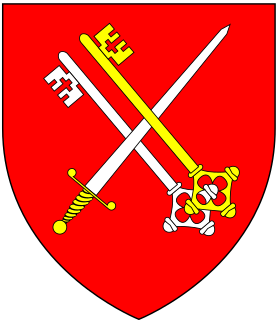Related Research Articles
The Bishop of St Albans is the Ordinary of the Church of England's Diocese of St Albans in the Province of Canterbury. The bishop is supported in his work by two suffragan bishops, the Bishop of Hertford and the Bishop of Bedford, and three archdeacons.
William Senhouse, also called William Sever, was an English priest, successively Bishop of Carlisle, 1495–1502, and Bishop of Durham, 1502–1505.
William Alnwick was an English Catholic clergyman. He was Bishop of Norwich (1426–1436) and Bishop of Lincoln (1436–1449).
Finan of Lindisfarne, also known as Saint Finan, was an Irish monk, trained at Iona Abbey in Scotland, who became the second bishop of Lindisfarne from 651 until 661.
Robert Waldby was a native of York and friar of the Order of Saint Augustine who followed Edward, the Black Prince into Aquitaine. After studying at Toulouse, he became professor of theology there.
Thomas Brunce was a 15th-century Bishop of Rochester and then Bishop of Norwich.

The Bishop of Rochester is the ordinary of the Church of England's Diocese of Rochester in the Province of Canterbury.

The Bishop of Winchester is the diocesan bishop of the Diocese of Winchester in the Church of England. The bishop's seat (cathedra) is at Winchester Cathedral in Hampshire. The Bishop of Winchester holds ex officio the office of Prelate of the Most Noble Order of the Garter since its foundation in 1348, and Bishops of Winchester often held the positions of Lord Treasurer and Lord Chancellor ex officio. During the Middle Ages, it was one of the wealthiest English sees, and its bishops have included a number of politically prominent Englishmen, notably the 9th century Saint Swithun and medieval magnates including William of Wykeham and Henry of Blois.

Gundulf was a Norman monk who went to England following the Conquest. He was appointed Bishop of Rochester and Prior of the Cathedral Priory there. He built several castles, including Rochester, Colchester and the White Tower of the Tower of London and the Priory and Cathedral Church of Rochester.
Adam Orleton was an English churchman and royal administrator.
Edmund Audley was Bishop of Rochester, Bishop of Hereford and Bishop of Salisbury.
Reginald Boulers was a medieval Abbot of Gloucester, Bishop of Hereford and Bishop of Coventry and Lichfield.

Richard Redman was a medieval Premonstratensian canon and abbot of Shap Abbey, Bishop of St Asaph, Bishop of Exeter, and Bishop of Ely, as well as the commissary-general for the Abbot of Prémontré between 1459 and his death.
Robert Gilbert was a medieval Bishop of London.
Siward was a medieval Bishop of Rochester.
Arnost was a medieval Bishop of Rochester.
Richard Wendene was a medieval Bishop of Rochester.
Lawrence of St Martin was a medieval Bishop of Rochester.

Richard FitzJames was a medieval Bishop of Rochester, Bishop of Chichester and Bishop of London.
Herman (died 1078) was a medieval cleric who served as the Bishop of Ramsbury and of Sherborne before and after the Norman conquest of England. In 1075, he oversaw their unification and translation to Salisbury. He died before the completion of the new cathedral.
References
- Fryde, E. B.; Greenway, D. E.; Porter, S.; Roy, I. (1996). Handbook of British Chronology (Third revised ed.). Cambridge: Cambridge University Press. ISBN 0-521-56350-X.